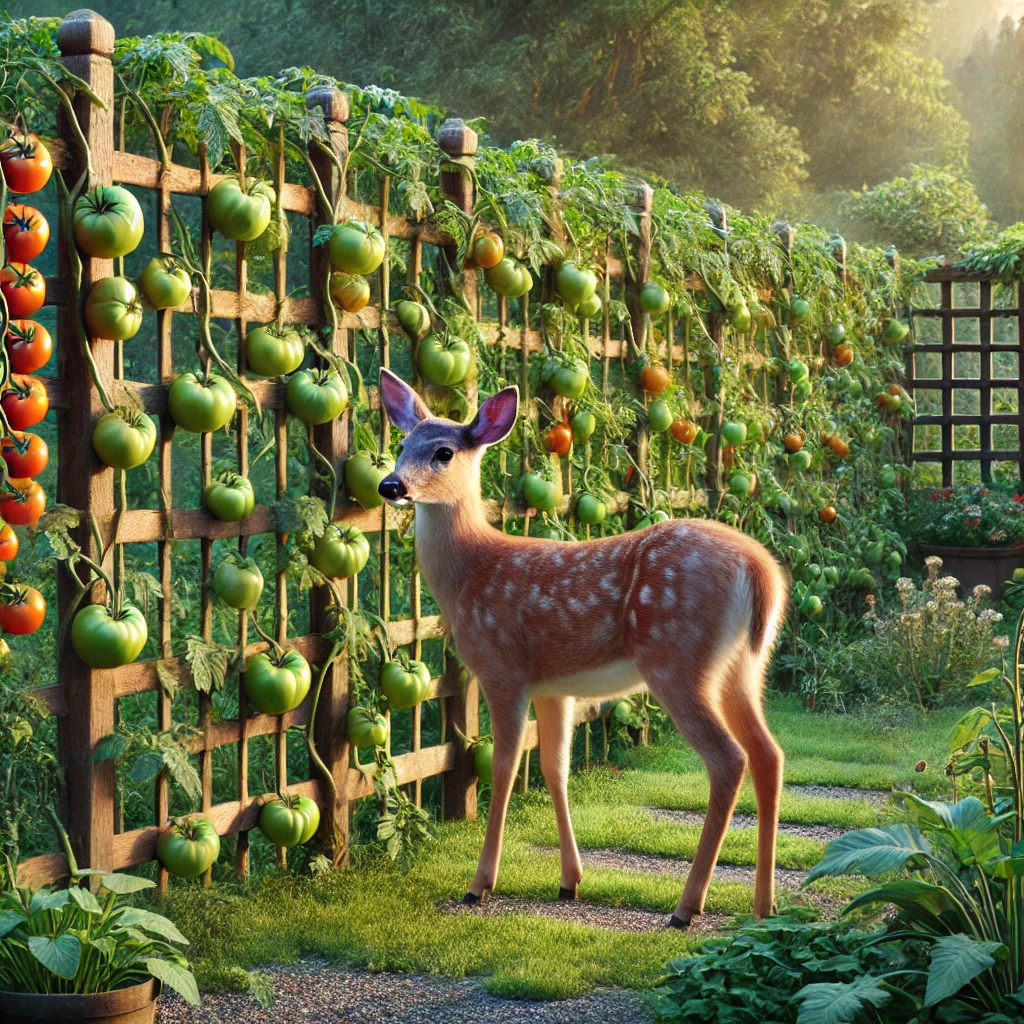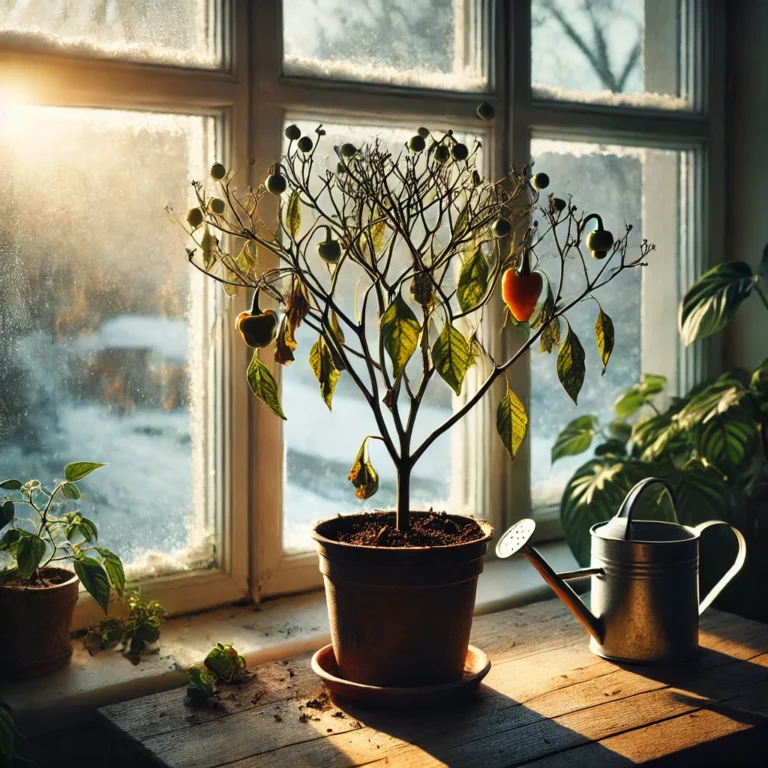You spend hours tending to your garden. You have spent countless hours watering, weeding, and grooming the perfect harvest. Then, one morning, you awake and find out that the deer have turned it into their personal buffet overnight. While fencing can be a great deterrent, not everyone has the space, budget, or desire for tall barriers around their garden. That is why I was intrigued when I recently received a question from a fellow gardener about my natural deep repellent. He asked, “How is it possible that I keep deer out of my garden by simply planting tomatoes, peppers, eggplants, and even potatoes outside of my low-fenced garden?”
The answer lies in what these nightshade family plants bring to the table. Plants like tomatoes, peppers, eggplants, potatoes, petunias, tomatillos, and even goji berries contain naturally bitter alkaloids and are potentially toxic to many animals, including deer. In simple terms, the compounds make the plants less appetizing, effectively acting as a natural repellent. Deer are known to be cautious grazers, and they often avoid plants with strong scents or unusual tastes that might upset their digestive systems. So, strategically planting nightshade crops along the garden’s outside perimeter creates a natural barrier that deters deer from proceeding further into your garden.
The science behind nightshade plants as deer deterrents
While it might sound like garden folklore, there are some solid reasons behind using nightshade plants to keep the deer at a distance. The nightshade family, scientifically known as Solanaceae, is made up of a wide variety of plants that contain a natural compound called alkaloids. The alkaloids, like solanine, are found in tomatoes and potatoes or capsaicin in hot peppers. Both serve as a naturally occurring defense mechanism against herbivores.
Deer, like so many wild animals, are selective eaters. They will typically avoid bitter, toxic, or otherwise unappetizing plants, especially when other food sources are available. Tomato foliage, for example, emits a strong, pungent odor that puts them off. Similarly, hot peppers can irritate a deer’s sensitive mount and throat, thanks to our friend capsaicin, which is the compound that gives chili peppers their heat.
What Gardeners are saying: Real-world experiences
Many gardeners have shared their experiences with me over many decades. A gardener I met from the western part of New York told me she saw a significant drop in deer damage after planting a border of tomatoes and pepper plants around her garden. “It was completely by accident,” she stated. “I was crop rotating, and that is where I moved those plants too, and then noticed how the deer passed by the garden without even going in”. Another gardener I met here in the south swears his family has been planting tobacco plants along the garden’s perimeter for as long as he can remember. The leaves’ strong scent and bitter taste keep the deer from nibbling at her lettuce and beans hidden only a few feet away.
But it is important to note that it is not just the taste that deters them; scent alone can be enough to camouflage your precious harvests and keep the deer passing by your garden. Deer tend to avoid areas with a strong odor, especially when unfamiliar or unpleasant. Companion planting nightshade crops with your more vulnerable plants can be an effective strategy. By surrounding your garden with a protective ring of nightshade plants, you create a natural scent barrier that deer are hesitant to cross.
Five other methods to keep deer out of your garden
While nightshade plants can certainly help, it is often best to us a multi-pronged approach when try to protect your garden from a dreaded deer invasion. Here are five other tried-and-true methods that gardeners use:
1. Using strong-smelling plants: Besides nightshades, plants like garlic, onions, lavender, basil, and rosemary are known for their aromatic scents, which deer typically avoid. Plant these around the garden or sprinkle them among your vegetables for additional protection.
o Bonus tip – Basil is a great companion for tomatoes, as its strong aroma repels pests like aphids and attracts beneficial insects that support plant health. It may also enhance tomato flavor and reduce the risk of fungal diseases, making it a valuable addition to your garden.
2. Install motion-activated sprinklers: Deer are easily startled, and a sudden burst of water will send them running to the next county over. Motion-activated sprinklers are among the humane approaches to deter deer and other wildlife from entering your garden.
3. Create physical barriers: While tall fences are the most effective, even a low, temporary wall or structure can help. You can use a fishing line strung at various heights around your garden. Deer can’t see the fishing line very well, and the unexpected feeling of a line on their bodies can deter them.
o Bonus tip – Use a string Trellis for your indeterminate tomato plants, as they can grow eight feet tall or higher, giving you a tall natural fence for the season. The simple process keeps them off the ground and supports good air circulation, preventing diseases and allowing easier harvesting and visual pest inspections.
4. Homemade Deer Repellents: Gardeners often make a DIY spray made from eggs, garlic, hot peppers, or soap to keep the deer away from their garden. A popular simplistic method is to hang bars of soap (especially Irish Spring) around the garden. Deer strongly dislikes the strong perfume smells.
5. Scare Tactics: Hanging reflective objects like old CDs, aluminum foil, or pinwheels can create random visual deterrents. Deer are cautious animals by their true nature, so anything that catches their eye and moves unpredictably can be effective.
Why is soap so effective in keeping the deer away?
Soap is a popular deer deterrent among gardeners. Many of my gardening friends swear by using strong-scented soaps like Irish Spring, which they hang from stakes, trees, and even the fence around the garden. The tried and tested theory is that soap and its intense fragrance mask the smell of the plants, which confuses the deer and makes them less likely to explore that area for food.
However, like many deterrent methods, the effectiveness of soap can vary. I have heard several gardeners report that deer around their garden quickly adapt to the scent of soap, especially when it is the only line of defense. However, soap can become a good element within a comprehensive deer deterrent plan when you use soap in combinations or other strategies, like planting nightshades or motion-activated sprinklers.
Other smells and textures that deter deer
We keep mentioning a deer’s acute sense of smell, but combining these with a few strategically textured plants can exploit even more of a deer’s distaste vulnerability. While we gardeners enjoy the pleasant aromas or the beauty of unique foliage, deer often find the same features unappealing. By incorporating plants that deter deer through scent, texture, and strategic placement, you create an inviting environment for the gardener but not the herbivore-loving nuisance.
Other Smells and Textures That Deter Deer
Deer have an acute sense of smell and texture preferences, which gardeners can strategically exploit to protect their plants. While we enjoy pleasant aromas or the beauty of unique foliage, deer often find these features unappealing. By incorporating plants that deter deer through scent, texture, and strategic placement, you can create an inviting environment for gardeners while discouraging deer.
Scents That Deter Deer
- Mint: The strong aroma of mint leaves overwhelms deer’s sensitive noses. Plant mint around the garden or use peppermint oil sprays.
- Garlic: The pungent odor of garlic masks the scent of more enticing plants, making it an effective companion plant for deer-prone gardens.
- Cayenne Pepper: The heat from cayenne pepper irritates a deer’s nose and mouth. Sprinkle ground cayenne pepper around your garden for added protection.
- Cinnamon and Clove: These spices have strong, deer-repelling aromas. Use them in homemade sprays or sprinkle ground spices near garden beds.
- Human Hair: The scent of humans, introduced by placing bags of hair around the garden, can deter deer.
Textures That Deer Avoid
- Prickly Plants: Plants like holly, barberries, or roses have spiky leaves or thorns that discourage deer from grazing.
- Fuzzy Leaves: Plants such as lamb’s ear have soft, fuzzy textures that deer find unpleasant to eat.
- Squishy Foliage: Succulents, like sedum or echeveria, have thick, squishy leaves that deer tend to avoid.
For added protection, consider creating a “living wall” using cascading or climbing plants like petunias. Varieties such as the Old-Fashioned Vining Petunia can be planted in hanging containers on fences, forming an incredibly fragrant and visually stunning barrier. Deer find petunias’ aroma unappealing, especially when combined with other deterrent plants, making them a practical addition to your garden defenses while attracting beneficial pollinators.
By combining aromatic plants, prickly textures, and strategic placement, gardeners can cultivate a space that’s both aesthetically pleasing and functional. While you enjoy fragrant herbs, vibrant flowers, or soft greenery, deer will find the environment uninviting and move on to easier grazing grounds.
When all is said and done, use a multi-pronged approach
For me, garden space is always a battle, and so are the deer for that fact. I feel I have killed the proverbial two birds with one stone. Moving my nightshade plants outside my established, fenced-in garden created space for more wonderful vegetables while also turning my garden into a well-shielded environment for my more vulnerable plants.
Gardening is mostly about experimenting and finding what works best for your unique situation. Deer are adaptable creatures, and what works in one season might not be as effective in the next, especially if food becomes scarce. So, if you’re battling deer in your garden, why not give nightshade plants a try? Combine them with other deterrents like strong-smelling herbs, motion-activated sprinklers, homemade sprays, and plants with unique textures and tastes, and you might win the war against these four-legged invaders.
Happy gardening, and may your garden stay lush and deer-free!



